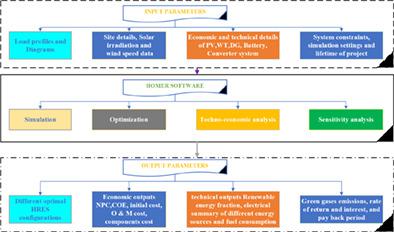当前位置:
X-MOL 学术
›
Int. Trans. Electr. Energy Syst.
›
论文详情
Our official English website, www.x-mol.net, welcomes your
feedback! (Note: you will need to create a separate account there.)
Optimal design and techno-economic analysis of a hybrid grid-independent renewable energy system for a rural community
International Transactions on Electrical Energy Systems ( IF 1.9 ) Pub Date : 2021-07-05 , DOI: 10.1002/2050-7038.13007 Harish Kumar Pujari 1 , Mageshvaran Rudramoorthy 1
International Transactions on Electrical Energy Systems ( IF 1.9 ) Pub Date : 2021-07-05 , DOI: 10.1002/2050-7038.13007 Harish Kumar Pujari 1 , Mageshvaran Rudramoorthy 1
Affiliation

|
Hybrid renewable energy systems (HRES) are proving a promising solution for rural electrification in India, where grid power availability is limited. This paper aims to identify the optimal design and pre-feasibility techno-economic analysis of the hybrid grid-independent renewable system for rural electrification. The proposed hybrid system integrates the various renewable energy system configurations to provide continuous power for the electric load demands of Kanakadri palle village, Andhra Pradesh, India. HOMER software is utilized to design the proposed hybrid system, perform optimization, techno-economic analysis, and simulation. Here, six different hybrid system configurations were taken into account to perform a comparative economic analysis. The results obtained shows that one of the hybrid systems, PV/DG/converter/battery system (120 kW-PV modules, 54 kW-DG, 200 number of batteries with 260 Ah ratings, and 50 kW-power converters), is the least economical optimal system based on least net present cost and Levelized cost of energy (COE), highest renewable fraction, and zero unmet electric loads percentage (NPC: $341 280, COE: $0.217, highest renewable fraction: 96.6% and unmet electric loads: 0%). For the site considered, this optimal hybrid system can provide a reliable power supply to the total energy requirements of 332.97 kWh/d and achieve 75.68% carbon emission reduction compared to a diesel generator. Moreover, the comparison of different system configurations was carried out based on economic analysis. This analysis shows that proposed hybrid system can be an appropriate model to provide reliable power at a low generation cost for the village considered in this study and can be recommended for future electrification projects.
中文翻译:

农村社区混合电网独立可再生能源系统的优化设计和技术经济分析
混合可再生能源系统 (HRES) 被证明是印度农村电气化的一个有前途的解决方案,因为印度的电网电力供应有限。本文旨在确定用于农村电气化的混合电网独立可再生能源系统的优化设计和预可行性技术经济分析。拟议的混合系统集成了各种可再生能源系统配置,为印度安得拉邦 Kanakadri Palle 村的电力负载需求提供持续电力。HOMER 软件用于设计拟议的混合系统,执行优化、技术经济分析和模拟。在这里,考虑了六种不同的混合动力系统配置来进行比较经济分析。获得的结果表明,混合系统之一,PV/DG/转换器/电池系统(120 kW-PV 模块、54 kW-DG、200 个额定容量为 260 Ah 的电池和 50 kW 功率转换器)是基于最低净现成本和能源平准化成本 (COE)、最高可再生比例和零未满足电力负荷百分比(NPC:341 280 美元,COE:0.217 美元,最高可再生比例:96.6% 和未满足电力负荷:0%)。对于所考虑的场地,这种优化的混合动力系统可以为 332.97 kWh/d 的总能源需求提供可靠的电力供应,与柴油发电机相比,碳排放量减少 75.68%。此外,在经济分析的基础上进行了不同系统配置的比较。
更新日期:2021-07-05
中文翻译:

农村社区混合电网独立可再生能源系统的优化设计和技术经济分析
混合可再生能源系统 (HRES) 被证明是印度农村电气化的一个有前途的解决方案,因为印度的电网电力供应有限。本文旨在确定用于农村电气化的混合电网独立可再生能源系统的优化设计和预可行性技术经济分析。拟议的混合系统集成了各种可再生能源系统配置,为印度安得拉邦 Kanakadri Palle 村的电力负载需求提供持续电力。HOMER 软件用于设计拟议的混合系统,执行优化、技术经济分析和模拟。在这里,考虑了六种不同的混合动力系统配置来进行比较经济分析。获得的结果表明,混合系统之一,PV/DG/转换器/电池系统(120 kW-PV 模块、54 kW-DG、200 个额定容量为 260 Ah 的电池和 50 kW 功率转换器)是基于最低净现成本和能源平准化成本 (COE)、最高可再生比例和零未满足电力负荷百分比(NPC:341 280 美元,COE:0.217 美元,最高可再生比例:96.6% 和未满足电力负荷:0%)。对于所考虑的场地,这种优化的混合动力系统可以为 332.97 kWh/d 的总能源需求提供可靠的电力供应,与柴油发电机相比,碳排放量减少 75.68%。此外,在经济分析的基础上进行了不同系统配置的比较。











































 京公网安备 11010802027423号
京公网安备 11010802027423号